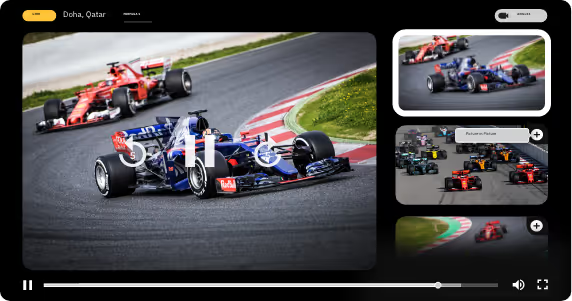May 28, 2022
Streaming
|
Published by
Mobii Systems
Behind your screen
Got your snacks and drinks ready to watch the game this weekend? You may watch “the beautiful game” on your screen, but behind the screen, another play-by-play is going on to make sure you don’t miss even one second of the match.
Meet the players:
- HTTP Live Streaming (HLS): Adaptive bitrate streaming protocol based on standard HTTP transactions used on the web. It was developed by Apple Inc. in 2009, and was designed to optimize video playback for the available network speed and the screen’s best resolution. It supports video on demand (Over The Top platforms) as well as live-streamed video. According to the “2019 Video Developing Report”, HLS has become the most popular streaming format with a broad use even outside Apple devices, like in Google Chrome browser, Android devices, and even Microsoft devices.
- Manifest File: A term borrowed from the transportation industry where a “manifest” is a document listing the cargo, passengers, and crew from a ship, aircraft, or vehicle. A Manifest File is a file that states important information about the streaming content like versions available, minimum bandwidth requirements, resolution, and formats. In HLS video streaming, the manifest files have the extension [.m3u8].
- Master Manifest: The Master Manifest or Primary Manifest is the first file the player reads before streaming. Here it can find a sort of index of available versions, based on resolution quality, each one followed by a link to the media. The player will choose the best one to fit your screen and network speed.
- Media Manifest: Once the player chooses the most suitable version, it follows a link to a Media Manifest which is a list of short video segments. Think of it as a playlist of “frame by frame” videos. This way, the player is constantly downloading small video bits at a time, which is what actually makes streaming possible. Your browser or player does not store the video, but only ‘projects’ one short segment at a time.
- Segments: In HLS video streaming, the segments are identified in the Media Manifest with the code (EXTINF) and the extension [.ts]. Each segment is numbered in order of appearance, so the player can download them correctly. They are usually between 2 and 6 seconds long.
- Buffering: To ensure smooth streaming, media players pre-load some segments. This process is called Buffering and is continuous all through any media content streaming. Think of it as a video stocking in your player, so streaming doesn’t get interrupted. However, buffering can be affected by slow connections.
- Content Delivery Networks (CDN): To ensure high-speed live streaming, platforms make extensive use of distributed content delivery networks (CDN), which store content in locations around the world that are much closer to users. This way if you’re watching a video in Los Angeles, your player will ‘connect’ to a server in California, instead of one in Florida. This helps reduce buffering time.
- Resolution: Resolution is defined as the number of pixels an image has. The more pixels, the higher the quality. The Master Manifest states the different resolutions available for the same video with the tag (RESOLUTION). Players in HLS are programmed to choose the best fitting resolution according to your device and network connection. This way, if you’re catching a YouTube video on your commute, it will likely choose a lower resolution, than if you’re watching a show on your smart tv wired to your home Wi-Fi.
- Bandwidth: Bandwidth determines the amount of data transferred through the network connection. The bigger the bandwidth, it means it can handle more data at the same time, which translates to higher quality video and faster buffering. The Master Manifest states the bandwidth requirements your player needs to stream video. It is easily identified with the tag (BANDWIDTH). The higher the resolution, the bigger the bandwidth needed in order to stream it smoothly, without interruptions. An average bandwidth for good HD live streaming is 5Mbps (Megabits per second), while for streaming video in 4K a 25Mbps bandwidth is recommended.
With a yearly consumption of more than 482 billion hours on live-streaming platforms and apps1, this is an all-star match. Game On!
1 “Live streaming - statistics & facts” – Statista. (2022)
Suggested reading
visit newsroom
‹

June 21, 2024
Streaming
Mobii Systems and UAR Rugby Join Forces to Revolutionize Rugby with Advanced Video and Data Technologies in Three-Year Partnership

January 26, 2024
Mobii Systems Completes AWS Foundational Technical Review Milestone for Its Ultra Low-Latency Streaming Solutions

December 11, 2023
Streaming
Mobii Leads the Way in Zero Latency Streaming: Join the Streaming Media Tech Talk

June 7, 2023
Streaming
Mobii ultra low-latency streaming services on Microsoft Azure now available in the Azure Marketplace
visit newsroom
‹
Join our newsletter
Industry insights and innovation within your reach.
Subscribe for original content and announcements.
Subscribe for original content and announcements.

Newsroom







.png)

.avif)


